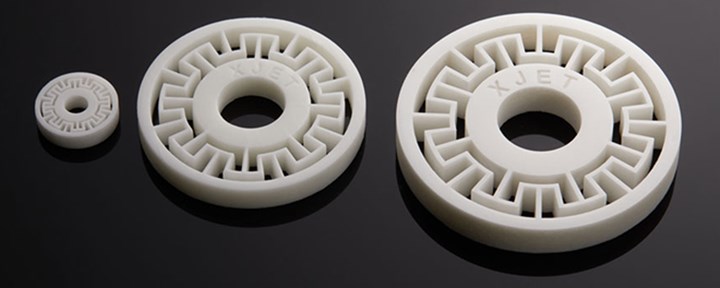AM 101: NanoParticle Jetting (NPJ)
The proprietary process from XJet builds ceramic and metal parts using nanoparticle suspensions. Learn how NPJ works in this introductory article, part of our AM 101 series.
Share
How Does NPJ Work?
NPJ jets a liquid that contains nanoparticles of metal or ceramic material in suspension to build up the part, while simultaneously jetting a support material. The process takes place in a heated bed held at 250°C, which allows the liquid to evaporate upon jetting so that the particles adhere in all directions. The resulting 3D object has only a small amount of bonding agent in its body and supports; to remove the binder and achieve its final density, a sintering step is also needed.
What Materials Can Be Used?
At time of writing, Xjet supports NanoParticle Jetting with 316L stainless steel and two ceramic materials, zirconia and alumina. The material is installed in the machine via cartridge, with no processing or handling required.

Examples of ceramic parts made with NanoParticle Jetting. Photo: XJet
What Postprocessing Is Required?
After printing, NPJ parts still retain a small amount of bonding agent and may have support structures. The support material is water-soluble and can be dissolved in a water bath. The green parts are about 60% dense and durable enough to be machined or polished at this stage if required.

An example of a part made via NPJ with the soluble support material still intact. Photo: XJet
Then, the parts are sintered in an oven to remove the remaining bonding agent. The sintering process results in about 13% of linear and isotropic shrinkage for metal parts, and 17.8% per dimension for ceramics, XJet says.
Why Use NPJ?
NanoParticle Jetting is capable of manufacturing many small parts at once. The material jetting process can be controlled droplet by droplet within ±25 microns for small parts and ±50 microns for larger MIM/CIM parts, according to XJet. Minimum feature size is 100 microns and layer height can be 8 to 10 microns, which allows for fine detail.
Because NPJ uses material in suspension, it avoids the need for sieving and other steps required with powder-based processes. The material can be printed in normal atmosphere with no gas, vacuum or pressure required, and can be easily recycled.
Applications for NanoParticle Jetting include hearing aids, surgical tools, crowns, bridges and drill guides for the medical industry; high-temperature and friction-resistant parts for aerospace and automotive (including pistons used in racing); and sensors for the electrical industry.
Related Content
-
Postprocessing Steps and Costs for Metal 3D Printing
When your metal part is done 3D printing, you just pull it out of the machine and start using it, right? Not exactly.
-
AM 101: What Is Hot Isostatic Pressing (HIP)? (Includes Video)
Hot isostatic pressing has long been used for metal castings, but is now being applied as a valuable method for closing porosity in metal 3D printed parts.
-
Video: What Is Electron Beam Melting (EBM)?
Electron beam melting is the higher-energy metal 3D printing process offering advantages when it comes to productivity and thermal stresses. Here is an introduction to EBM.
.jpg;width=70;height=70;mode=crop)